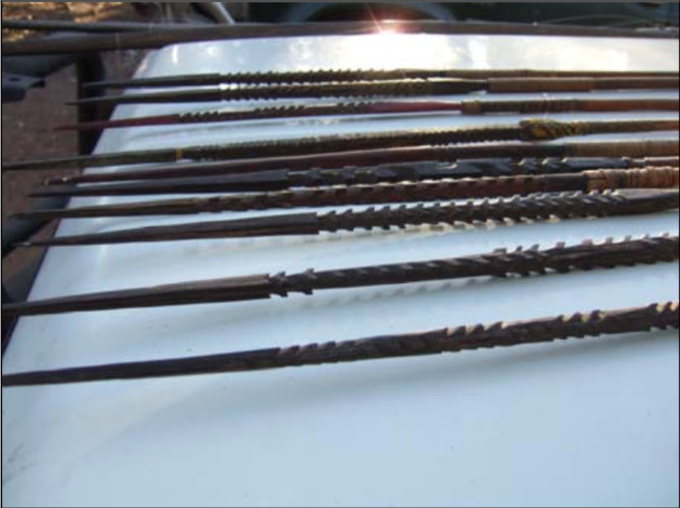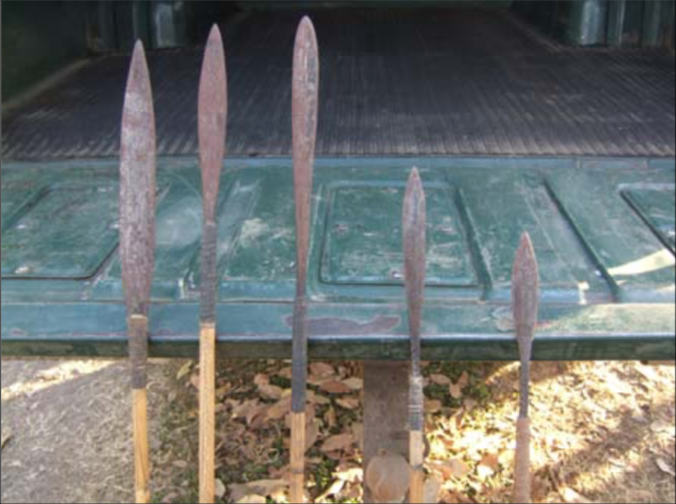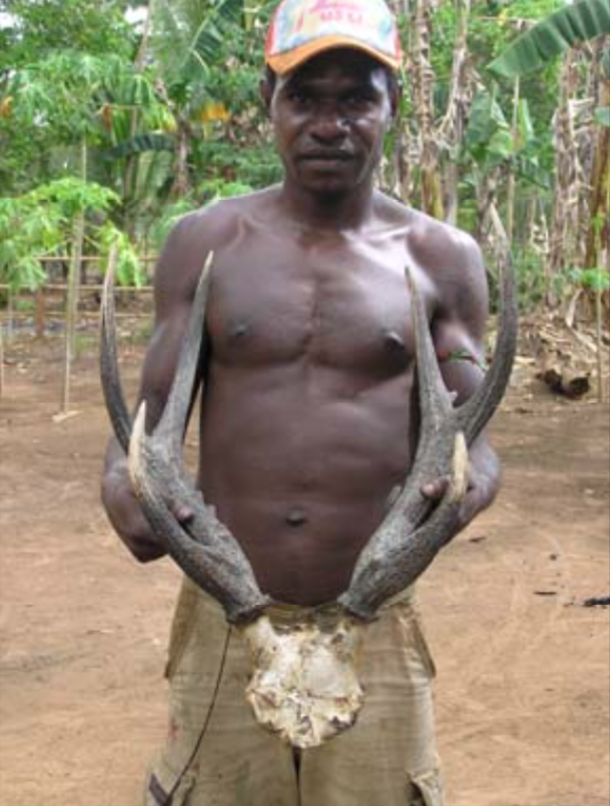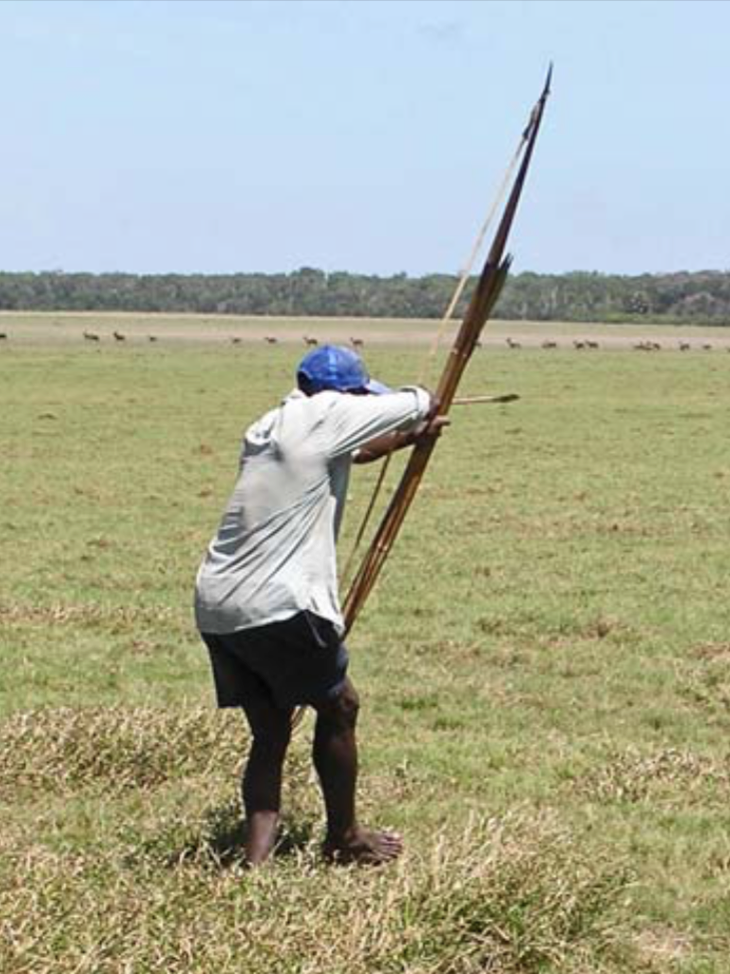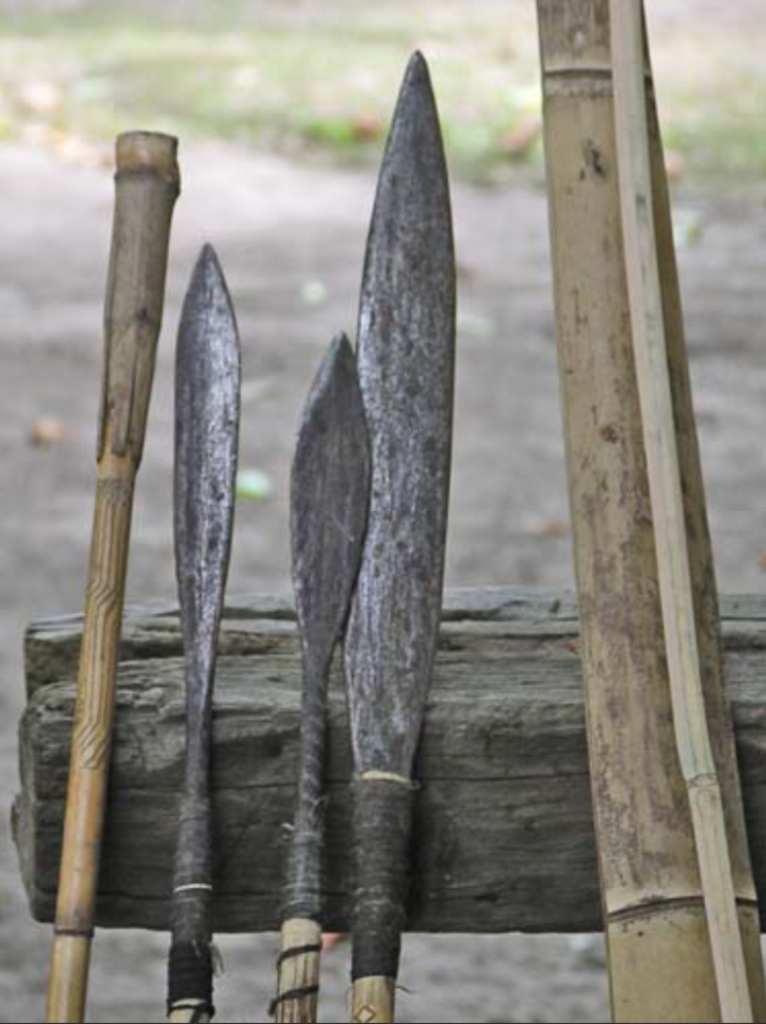Editor’s Note:
The Ashby reports are graciously compiled and published free of charge by the folks at Alaska Bowhunting Supply and are readily available to anyone that visits their website. These reports are a wealth of knowledge and field testing. We are very grateful to ABS for allowing us to re-publish some of this incredibly in-depth content. Dr. Ed Ashby allowed Alaska Bowhunting Supply to use his name on their broadheads with one condition. He insisted that ABS make it clear he receives no compensation for the use of his name whatsoever.
I recently had the opportunity to examine some bows and arrows used by the tribal hunters of Papua New Guinea (PNG) in great detail. There were two equipment sets: one reflecting the equipment in contemporary use, the other from the pre-WWII era. The earlier equipment is distinctly different from that in use today. Examination of these two sets of equipment, separated by a half century of change, reveals many interesting features. Though they may not necessarily reflect changes throughout PNG, they clearly do for one region. Increased contact with the outside world has brought many changes to tribal life in PNG, but most rural natives still subsist primarily as hunter-gathers. PNG has numerous species of game. Those most commonly subsistence-hunted in the Tonda/Bula Plains region, where these bows originate, are Rusa deer, pigs and crocodiles, along with various kinds of small game and fish.
Both stalking and stand hunting are common methods used for the larger animals. Considering the appearance of the equipment used, it was surprising to discover that these tribal hunters routinely take game at 25 yards or more with their lengthy, un-fletched arrows, especially the Rusa deer. The open-country dwelling Rusa are primarily hunted by stalking. Though they often stalked as a team, only one hunter shoots at a time.
Among the equipment examined were three bows. Two were pre-WWII era bows made of black palm and one was a contemporary bow, made from bamboo. The bow design from these two eras is vastly different, but all three bows are of heavy draw weight. The older bows are carefully crafted and carried flat, braided strings of plant fibre, though most of their string is now missing. One of the early-era bows is a bit over sixty-three inches long, the other a shade over sixty-seven inches. Because of the age and rarity of the bows, stringing them was not possible. Feeling the floor-tiller, and comparing it to my own 82 pound longbow, I estimated the draw weight of each to be approximately 80 pounds. The shorter black palm bow originally had four braded fibre wraps, evenly spaced along the bow’s limbs. Though two are now missing the imprint of their location is clearly visible. The longer bow had no wraps. Wrap construction is similar to that of the remnants of remaining bowstring. The wire visible to the right is to hang the bow for display.
The contemporary bow is much more crudely finished than the earlier bows, but is very well tillered. Though I had no scale to measure it, this bow was estimated to draw at least in the upper eighty pound range, possibly 90 pounds, if not a bit more. All of my own commonly used longbows are in the 70 pound to 90 pounds range (at my 27″ draw) and I think the draw weight estimate is fairly close. In shooting their bows, the natives draw to an anchor point at the side of the face, rather than the corner of the mouth. Their average draw length is similar to my own.
The contemporary bow is a simply made, and more roughly-finished, section of bamboo. It is just over seven feet long. The finished bow length is dictated by the pattern of rings on the individual section of bamboo. The bamboo’s outer section forms the bow’s facing and the concave inner core forms the backing. The contemporary bow’s string is made from a single bamboo strip, about 3/8″ wide. It is carefully chamfered along its entire working length. None of the arrow shafts have nocking grooves. The flat base of the arrow shaft is placed against the flat string.
Regardless of whether the bamboo string’s ends are left flat or frayed and twisted into cord, the string loops are formed using a wooden wedge. The string is first wound around itself and the tip of a wooden wedge. It is then wound around itself underneath the wedge, passed over a carved projection at the thick end of the wedge and wrapped back around itself underneath the wedge again. The string’s end is then tucked underneath the wraps and wedge’s tip. Stringing the bow securely tensions the wraps and wedge arrangement. The wedge’s tip faces the bow’s nock.
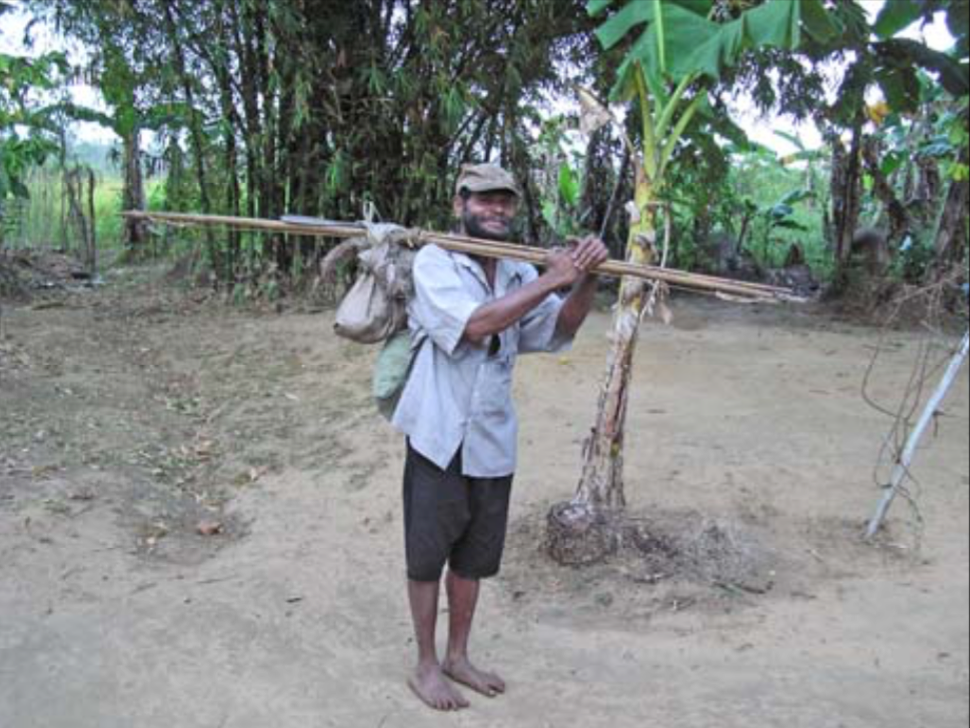
Since I have a special interest in hunting arrows and their terminal performance, I spent a great deal of time examining and measuring the two sets of arrows, those from the pre-WWII era and the contemporary ones. None of the arrows have nock groves or fletching, yet PNG hunters demonstrate a considerable degree of accuracy with their arrows. They can almost effortlessly centre a 10″ diameter tree from 20 yards with their outsized, blunt-point small game arrows and both Rusa deer and pigs are commonly taken at ranges of 25 yards or more. The shooting form they use is very natural in appearance. Shoulders rolled forward a bit, a slight bend at the waist, elbow of the bow arm slightly bent, shoulder of the shooting arm elevated in line with the arrow and the bow canted. Their draw to anchor, at the side of the face, is smooth and steady, with only a momentary pause at full draw before they relax their split-finger release. They use a very open stance, either facing the target squarely or at a very slight angle. Other than the appearance of their equipment, and their extremely open stance, they would look right at home at any traditional shoot.
The glaring difference between the two arrow sets is that those from pre-WWII all have barbed wooden points, whereas the contemporary arrows all have steel points of massive-dimensions. This results in a marked difference in arrow mass. While there is a stark difference in the quality of workmanship, fit and finish, between the pre-WWII and contemporary bows, all the arrows show that a great deal of attention has been applied to their construction. Though no two of the arrows are identical, each cane-shafted arrow shows a remarkable degree of straightness and balance. All the arrows showed straight shafts and excellent workmanship. The fore-shaft of each arrow, in both sets, is meticulously wrapped. One of the pre-WWII arrows shows a strikingly different, somewhat bulbous point attachment, though its purpose unknown.
When the average dimensions of each set of arrows are compared, we find the following: The contemporary arrows average 8.12 cm (3.2″) longer in overall length than those from the pre-WWII era, and their larger-diameter shafts (approximately ½” at the rear) average 23.42 cm (9.2″) longer. Though the contemporary arrows weigh an average of 2.47 times as much as their pre-WWII counterparts, their weight FOC averages only 2.1% more (using the AMO Standard FOC Formula). A larger sample size might well have shown the average FOC between the arrows sets to be even more consistent.
Though the ‘broadheads’ would show minimal wind-shear effect at the low velocity these setups are capable of, in order to achieve stable flight with an un-fletched arrow a high degree of arrow FOC is necessary. The average amount of FOC shown by the pre-WWII arrows is 34.6%. For the contemporary arrows it is 36.7%. Clearly, a major change in arrow design was necessary when steel points came into use, but the native arrowsmiths made an adjustment in shaft dimensions to maintain a relatively similar degree of arrow FOC. Now, I’m fairly certain that not one single PNG native arrowsmith has the slightest idea what arrow FOC is, what it means or what its function is. They reached the dimensions of their arrows by trial and error, altering the design until they had the degree of accurate arrow flight required for their hunting conditions.
Modern bowhunters have long considered 6% to 12% or 15% FOC as being the ‘traditional norm’ for arrows, but just exactly when did it become “traditional” to use such modest amounts of FOC in our hunting arrows? The few original stone-point Indian arrows I’ve had a chance to examine have shown from 20% to just over 40% FOC. Authentic arrows of oriental origin have typically shown FOC’s in the 30% to 40% range, as have most of the arrows I’ve seen in use by African tribes. We ‘moderns’ are just beginning to rediscover the many advantages of having high amounts of FOC in our hunting arrows—more stable flight, faster paradox recovery and a substantial boost in arrow penetration—things our ‘primitive’ counterparts have, apparently, long known. It was of great interest to see that wood-tipped spears are still in common use by the natives of PNG, yet wooden arrow points for big game hunting have been totally replaced by massive steel ones. Could it be that the ponderous steel-tipped arrows proved to penetrate and kill better than the lighter wood-tipped ones and the much heavier spears penetrated and killed equally effectively with either wood or steel points? The pre-WWII arrows average 955.6 grains in weight. The contemporary steel-tipped arrows average a hefty 2365.2 grains. If lighter steel-tipped arrows had proven to be equally effective, it would have been simple to make smaller steel points and lighter arrows, conserving the precious, and relatively scarce, supply of steel available.
It is with great incredulity that I so often hear modern bowhunters say that 650, 700, 800 or 900 grain arrows are far too heavy to hunt with and that they make hitting game at all but the very closest of ranges a near impossibility. Throughout the world hordes of primitive hunters whose very survival still depends on their ability to regularly take big game with their bows and arrows are using arrows many times that weight. Look back at the photos above and consider the open country the Rusa deer of PNG frequent. If a crude bamboo bow casting a 2000-plus grain arrow shoots sufficiently flat to routinely take these wary and extremely hard-hunted open-terrain animals, how can any modern bowhunter think the very heaviest of our modern arrows is too heavy to hunt with?
We ‘moderns’ still have much about bowhunting to relearn from our ‘primitive’ counterparts.
About the Author:
Dr. Ed Ashby invested 27 years in the study of arrow performance and broadhead lethality. His testing is the closest thing to the scientific method as is possible under field-testing conditions. Never before has anyone tested arrow and broadheads on actual game animals on such a scale. The test results have been carefully compiled and are now available to the public free of charge at Alaska Bowhunting Supply.
Bowhunters everywhere owe Dr. Ashby a debt of gratitude as his data reveals which broadheads and arrows perform the best on real game animals. The results show that whether you shoot a traditional bow like a recurve or longbow, or a compound, the arrows and broadheads that performed well in testing, will perform for you where it matters most, in the field.
His goal is to educate the world on what kinds of arrows and broadheads best penetrate big game animals. He receives no compensation for any of his research but shares the results freely. He wants to educate bowhunters everywhere on what works best on big game animals so the animals may be harvested in the most efficient manner possible.


